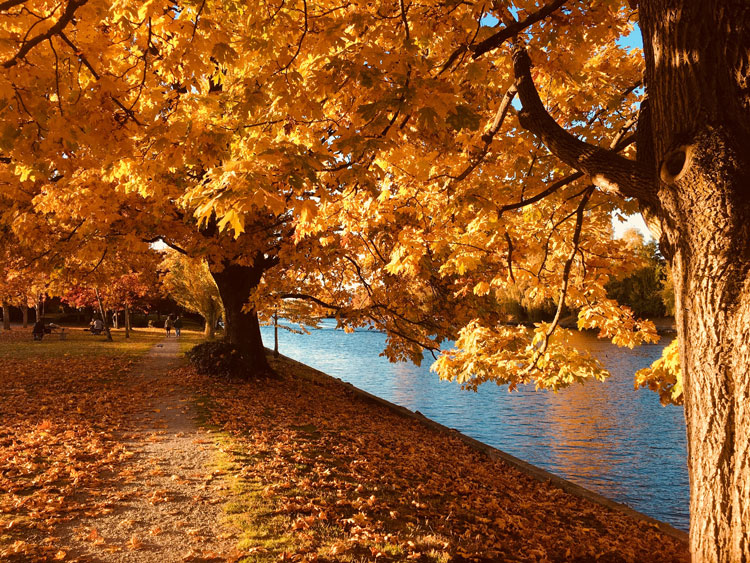26th Sep 2024
As the seasons change and we approach the autumnal months, it’s time to give your pond some extra attention. Proper autumn care will ensure your aquatic ecosystem remains healthy and vibrant throughout the winter months. Here's a step-by-step guide to help you prepare your pond for the colder season:
Step one: Remove debris from the pond surface
As leaves begin to fall and the growing season comes to an end, debris can quickly accumulate on your pond’s surface. While you may have kept an eye on floating leaves, twigs, and other debris during the summer, autumn means a much thorough deep-clean. Leaves and dead plant material will start to decompose in the water, which releases harmful gases like ammonia and methane. This decomposition can lead to oxygen depletion and can have an impact on your fish and other aquatic life.
Steps to Remove Surface Debris:
· Use a Pond Skimmer: A pond skimmer is highly effective for removing surface debris like leaves and small twigs. Make sure to use it daily during peak leaf fall.
· Deploy a Net: Invest in a high-quality pond net to scoop up larger debris. This is especially useful for areas where overhanging branches are prone to shedding leaves.
· Preventative Pruning: Trim back any overhanging branches before they have the chance to drop their leaves into the water. Prevention is often easier than cleaning up.
Regularly removing debris from your pond will prevent it from settling on the bottom and contributing to a buildup of sludge, which can cause water quality issues later on.
Step Two: Cut back and trim down marginal vegetation
Marginal plants, which grow around the edges of your pond, begin to die around autumn and need to be trimmed or cut down. This keeps your pond looking tidy, but it also helps maintain the ecological balance by preventing excess organic matter from decomposing in the water.
Guidelines for Trimming Vegetation:
· Cut Down to 15cm Above Water Level: As a general rule, trim marginal plants to no more than 15 cm (6 inches) above the winter water line. This keeps them manageable and prevents them from overtaking the pond.
· Balance Vegetation Coverage: Aim to keep about 50% of the pond surface free from vegetation. This ensures a healthy balance between oxygenating plants and open water, which is vital for the well-being of fish and other pond inhabitants.
· Mind Late Flowering Species: Some plants, such as certain water lilies and Water Hawthorn, bloom late into the autumn. Be cautious not to cut these back prematurely, as they can add colour and interest to your pond late into the season.
Step Three: Manage low growing and aquatic plants
Low-growing and aquatic plants, such as water lilies, are important for your pond's ecosystem as they provide shelter for fish and stabilise the pond environment. But, as temperatures drop, their growth slows, and many of their leaves and stems start to yellow and die off.
Steps for Managing Aquatic Plants:
· Remove Yellowing Leaves: As soon as you notice water lily leaves turning yellow, trim them back to prevent them from decaying in the water. However, healthy, green leaves can be left in place until they begin to wither.
· Thin Out Overgrown Plants: If certain plants have become too dense, now is a good time to thin them out. This ensures that your pond doesn’t become overcrowded, which can lead to oxygen depletion.
· Dispose of Unwanted Plants: If there are any plants you wish to remove entirely, autumn is the ideal time to do so. Simply lift them out, along with their planting baskets, and dispose of them in your compost heap.
Step Four: De-sludge the pond bottom
Over time, a layer of silt naturally builds up at the bottom of your pond. While a small amount of silt is beneficial as it provides a habitat for beneficial bacteria, too much can lead to problems. If left unchecked, this silt can turn into a thick layer of sludge that releases harmful gases and promotes the growth of algae, both of which can be damaging to your pond's health.
Tips for De-Sludging:
· Use a Fine Mesh Sludge Net: Gently drag a fine mesh net along the pond bottom to collect excess sludge. Be careful not to stir up too much sediment, as this can cloud the water and stress your fish.
· Consider a Pond Vacuum: For a more thorough cleaning, use a pond vacuum to remove heavier sludge deposits. This is particularly useful if your pond hasn’t been de-silted in a few years.
· Dispose of Sludge Properly: The sludge you collect can be added to your compost pile, where it will break down naturally and provide rich nutrients for your garden.
Step Five: Prepare Fish and Pond Equipment for Winter
Autumn is also the time to start thinking about your fish and pond equipment as winter approaches. As the water temperature drops, fish activity decreases, and they enter a state of semi-hibernation.
Fish Care and Equipment Maintenance:
· Adjust Feeding: Gradually reduce the amount of food you give your fish as the water temperature drops. Once the temperature falls below 10°C (50°F), stop feeding altogether, as fish will no longer digest food efficiently.
· Check and Store Equipment: Clean and store any pond equipment that won’t be needed during the winter, such as UV clarifiers, pumps, and filters. Make sure to inspect all equipment for wear and tear before storing.
· Install a Pond Heater: If you live in an area where your pond might freeze over, consider installing a pond heater or de-icer. This will help maintain an open area on the water’s surface, allowing gases to escape and preventing fish suffocation.


